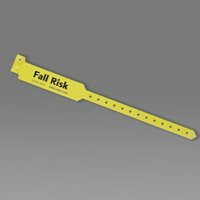Making Certain Specific Medicine Management with Patient Identification Band
Making Certain Specific Medicine Management with Patient Identification Band
Blog Article
Streamlining Individual Care With Reliable Identification Bands
The implementation of effective identification bands is a critical aspect in improving person treatment within medical care setups. As the landscape of person identification advances, one must think about the ramifications of these systems on general health care distribution and person end results.
Importance of Client Identification
Making sure precise individual recognition is critical in healthcare settings, as it straight impacts the safety and security and quality of care provided. Misidentification can cause severe mistakes, including administering the wrong drug, executing wrong treatments, or miscommunicating crucial patient details. Such mistakes not just threaten person safety yet can likewise lead to legal ramifications and reduced count on healthcare systems.
Efficient patient identification is fundamental to developing a secure atmosphere where patients obtain personalized and proper treatment. It helps with the accurate documents of medical backgrounds, allergies, and treatment plans, making sure that doctor have accessibility to crucial information at all times. Durable identification protocols help enhance interaction among clinical team, boosting cooperation and minimizing the threat of mistakes.

Types of Recognition Bands
Identification bands play a vital duty in keeping precise person documents and improving safety and security within healthcare environments. Numerous types of recognition bands are utilized to satisfy the details demands and needs of different patient populaces.

An additional kind is the ankle joint band, which is specifically helpful for newborns and babies, making sure that recognition stays undamaged even throughout care procedures. Specialty bands, such as those for allergic reaction notifies or drop danger indications, give added layers of security by drawing prompt interest to important individual conditions.
Recently, digital recognition bands have acquired popularity, incorporating barcodes or RFID innovation that can be checked to promptly get patient data. These bands simplify operations and reduce the danger of human error during client recognition processes.
Benefits of Efficient Recognition
Reliable identification of patients through using identification bands adds significantly to general client security and care high quality. By guaranteeing that each patient is accurately determined, doctor can efficiently match clinical treatments and procedures to the appropriate individual, reducing the risk of errors. This is particularly essential in settings with high individual turnover, where the potential for misidentification is greater.
Moreover, reliable recognition bands improve communication amongst healthcare teams. Accurate and clear person recognition promotes collaboration and ensures that all group members know a patient's details requirements and medical background. This interaction is necessary for providing coordinated treatment, especially in emergency situation circumstances where time is vital.

Inevitably, reliable recognition with using identification bands not just safeguards people yet likewise promotes a society of safety and security within health care centers (Patient Identification Band). By focusing on precise identification, medical care companies can enhance outcomes and boost the total individual experience
Carrying Out Identification Systems
While the relevance of patient recognition is well recognized, the implementation of durable identification systems postures a complicated challenge for medical care companies. Establishing reliable identification systems calls for a detailed method, incorporating innovation, personnel training, and procedure integration.
First, companies need to select ideal identification modern technologies, such as barcode scanning, RFID, or biometric systems. Patient Identification Band. These innovations should be examined based on expense, use, and compatibility with existing facilities. A pilot program can aid determine possible problems prior to full-scale execution
Next, detailed training for staff is crucial. All employees must comprehend the importance of precise client identification and be efficient in the use of the chosen modern technologies. Regular training updates and evaluations can reinforce best methods and guarantee continued conformity.
In addition, health care organizations must establish standard treatments for person identification throughout all divisions, lessening discrepancies and enhancing interaction. Normal audits can help identify voids in adherence to these protocols.

Inevitably, a reliable application of identification systems not only boosts client safety have a peek at this website and security however additionally promotes a society of accountability and persistance within medical care setups, ensuring dependable and consistent patient treatment.
Future Trends in Patient Identification
Advancements in technology are set to revolutionize patient identification practices in healthcare setups. The integration of biometric identification approaches, such as fingerprinting and facial recognition, is anticipated to improve precision and safety. These innovations can dramatically reduce the threat of misidentification, making certain that clients get the appropriate treatments and drugs.
Moreover, the application of blockchain technology for client documents is acquiring traction. This decentralized approach can offer a safe and tamper-proof approach for taking care of individual identities, therefore enhancing access to essential info across different doctor.
Another pattern is the increasing use of mobile wellness applications that take advantage of QR codes for person identification. These applications permit real-time updates and very easy accessibility to person information, empowering healthcare specialists to make enlightened choices quickly.
Furthermore, expert system (AI) is positioned to play a vital duty in evaluating patient identification information, determining patterns, and anticipating potential identification errors prior to they take place.
As these innovations progress, they promise not only to improve patient safety and security but also to improve the overall effectiveness of health care shipment systems. Welcoming these technologies will certainly be critical for future-proofing person care techniques.
Final Thought
Finally, reliable identification bands are important for boosting individual security and care quality within medical care setups. By decreasing the risks related to misidentification, these bands help with accurate and prompt information access, eventually improving interaction amongst medical care suppliers. The application of durable recognition systems not just read here fosters a culture of safety and security yet likewise positions healthcare institutions to adapt to future fads in person recognition modern technology, making certain ideal end results for patients in varied medical settings.
As the landscape of client recognition develops, one have to consider the ramifications of these systems on general health care shipment and person results.Reliable client identification is essential to developing a protected environment where patients obtain suitable and personalized care. Inevitably, focusing on efficient person recognition approaches not just fosters a society of safety yet also contributes to boosted individual end results and overall contentment with healthcare services.
Reliable identification of clients via the use of recognition bands contributes significantly to overall individual security and care quality. The application of robust identification systems not only promotes a culture of security yet also positions medical care institutions blog to adjust to future fads in client identification innovation, ensuring optimum results for patients in diverse medical environments.
Report this page